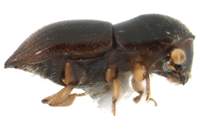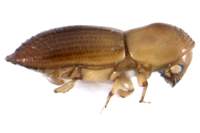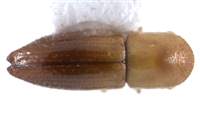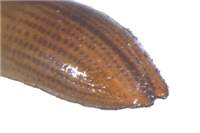Diagnosis
Coptoborus is diagnosed by an elongate body, by the antennal club with two sutures visible on posterior face, by the elytra attenuate or acuminate on apical third, with the sutural apex typically emarginate and by at least one declivital interstria bearing small denticles.
Distribution
Neotropical.
Biology
All species have been collected from small stems and branches.
Taxonomy
The Paleotropical genus Streptocranus was synonymized with Coptoborus in Wood & Bright 1992. Hulcr et al. (2007) found Coptoborus to be polyphyletic due to Streptocranus species. Steptocranus was resurrected as independent genus, however our observations suggest that Coptoborus may still be a polyphyletic combination of an endemic neotropical lineage and a lineage originating in the Old World and related to Debus.
Detailed description
Eyes shallowly emarginated, upper portion of eyes smaller than the lower part. Antennal club approximately circular, club type four not truncated, first segment anteriad smaller than second, both convex. Segment 1 of club circular around the club, concave frontally, covering the entire posterior face or straight (may be slightly concave or convex) on anterior face, its margin clearly costate around the antenna or mostly costate, appearing softer on the posterior side. Segment 2 of club partly corneous, visible on the anterior side only or visible on both sides of the club, but soft, or the corneous part on the anterior side only. Segment 3 of club clearly visible on both sides of club. Segment 1 of antennal funicle shorter than pedicel, funicle 4-segmented. Scapus regularly thick. Frons above epistoma mostly smooth, alutaceous, with minor punctures. Submentum flat, flush with genae, shaped as a narrow triangle. Anterior edge of pronotum with no conspicuous row of serrations (serrations dont differ from those on the pronotal slope). Pronotum from lateral view with pronotal disc as long or slightly longer than anterior slope (type 7). From dorsal view rounded frontally, longer than basic type 2 (type 7). Pronotal disc shining or smoothly alutaceous, with small punctures, lateral edge of pronotum obliquely costate. Procoxae contiguous, prosternal posterocoxal process short and conical, or flat and inconspicuous. Scutellum flat, flush with elytra. Elytral bases straight, with oblique edge, elytral disc longer than declivity, and convex or bulging, or mostly flat, punctures on elytral disc in strial lines (which may be difficult to discern). Boundary between elytral disc and declivity distinct or indistinct, disc rounded, smoothly transitioning into declivity. Lateral profile of elytral declivity slowly descending, often flat, dorsal profile of elytral apex prolonged apically, attenuated or angulate or concave, emarginated. Elytral declivity with few setae or scales, not conspicuously pubescent. Posterolateral declivital costa elevated with the carina short and inconspicuous or clearly visible but not extending beyond the seventh interstriae (usually less than half the declivital length. Surface of declivity devoid of tubercles or no tubercles on interstria 2, and several tubercles in interstriae 1, 3 and beyond. First interstriae parallel (sometimes slightly broadened towards elytral summit). Striae and interstria on the upper part of declivity even, flush with the surface. Protibia obliquely triangular, broadest in 2/3 of the length. Posterior side of protibia flat, with setae only. Protibial denticles small, bases of denticles not enlarged, protibial margin rounded, 6 8 protibial denticles present. Metatibia of normal size. Color uniformly light brown or reddish (pronotum sometimes slightly lighter). Length: 1.5 5.0 mm.





